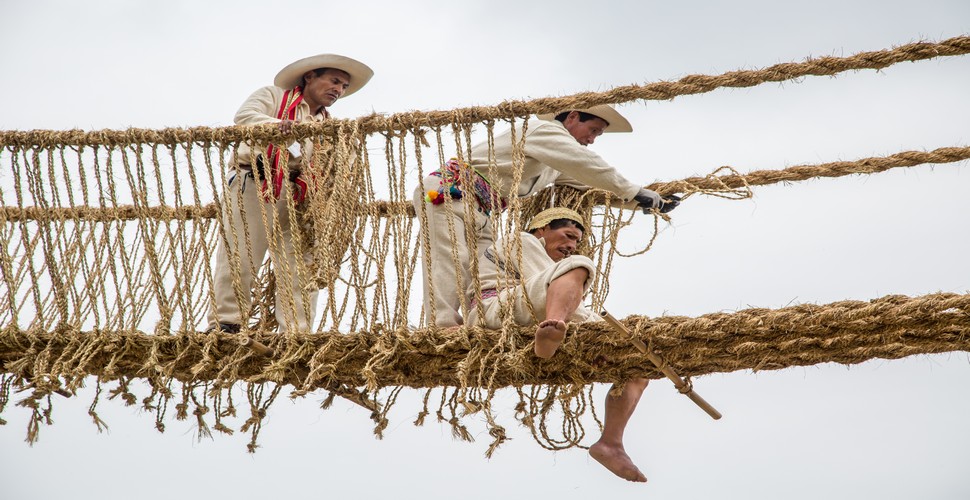

Claire Dean
Travel in South America is a joy to behold. The rich variety of destinations, experiences, landscapes and geography fascinated me so much, that I chose to relocate here, over 20 years ago! The best thing I ever did! Allow me to share my knowledge and passion for Central and South America with you and help you plan your holiday of a lifetime!

Q'eswachaka Bridge: A Living Testament to Inca Engineering
Written by:Claire Dean
Last Update: 2025-01-06
In the heart of the Peruvian Andes, amidst the breathtaking landscape of the Quehue District, just a few hours from Cusco stands a remarkable testament to the engineering prowess of the Inca civilization. The Q'eswachaka Bridge, a living suspension bridge handwoven from grass, has endured for centuries, connecting communities and preserving a cultural tradition that spans generations. This magnificent structure serves as a vivid reminder of the ancient heritage and ingenuity of the Andean people. Find out more about this unique Inca Bridge and what makes it so special.
Q'eswachaka Bridge
The Historical Significance
The Q'eswachaka Bridge sometimes referred to as the "Inca Rope Bridge," is an ancient marvel located over the Apurimac River in southern Peru. Its origins can be traced back to the Inca Empire, which flourished in the Andean region from the 13th to the 16th century. The bridge holds great historical significance, as it represents the advanced architectural and engineering knowledge possessed by the Inca civilization.
Uniting Communities
Construction and Design
What sets the Q'eswachaka Bridge apart is its unique construction technique and the materials used. The bridge is handwoven using traditional methods passed down through generations. The main component is "ichu", a type of grass that grows abundantly in the region. The blades of ichu are twisted into strong ropes, which are then interwoven to form the foundation of the bridge. Every year, in an extraordinary display of communal cooperation, local communities come together to rebuild the bridge. The process involves dismantling the existing bridge and replacing it with a new one using the same ancient techniques. This labor-intensive task requires the collective effort of hundreds of individuals, who work tirelessly to ensure the bridge's structural integrity.
Artistry and Engineering
Cultural Preservation
The annual reconstruction of the Q'eswachaka Bridge serves a dual purpose. On one hand, it ensures that the bridge remains functional and safe for crossing, allowing locals to commute between villages and access essential resources. On the other hand, it reinforces the cultural identity and heritage of the Andean communities. The bridge-building process becomes a celebration of indigenous traditions, strengthening community bonds and passing down ancestral knowledge to younger generations.
Q'eswachaka Magic
Symbolism and Spirituality
Beyond its practical purpose, the Q'eswachaka Bridge holds spiritual significance for the Andean people. It is believed to be a sacred link between the physical and spiritual realms. Rituals and ceremonies accompany the bridge's reconstruction, invoking blessings from the Apus (mountain deities) and Pachamama (Mother Earth). These spiritual practices affirm the bridge's role as a protector and connector, ensuring the well-being of the communities it serves.
Q'eswachaka Receives International Visitors
Preserving a Legacy
Despite the passage of centuries and the influence of modern engineering, the Q'eswachaka Bridge continues to stand as a living testament to the Inca civilization's engineering prowess and the resilience of the Andean people. Recognizing its historical and cultural significance, the bridge was designated a UNESCO World Heritage Site in 2013, further highlighting its importance as a global heritage treasure.
Intricate Weaving
Visiting the Q'eswachaka Bridge
For adventurous travelers seeking an extraordinary cultural experience, visiting the Q'eswachaka Bridge offers a unique opportunity to witness an ancient engineering marvel. The bridge is located approximately 180 kilometers southeast of Cusco, and its reconstruction usually takes place in June. Witnessing the vibrant ceremonies and exploring the surrounding natural beauty make for an unforgettable journey into Peru's rich heritage.
Q'eswachaka Bridge
The Q'eswachaka Bridge stands tall, not just as a physical structure but as a symbol of cultural resilience and communal cooperation. Its annual reconstruction serves as a reminder of the ingenuity and craftsmanship of the Inca civilization, as well as the unwavering commitment of the Andean communities to preserve their heritage. As long as the Q'eswachaka Bridge continues to span the Apurimac River, it will remain an enduring tribute to the ancient traditions and engineering prowess of the Andes. Find out more about a visit to the unique Inca bridge of Queswachaka here.













